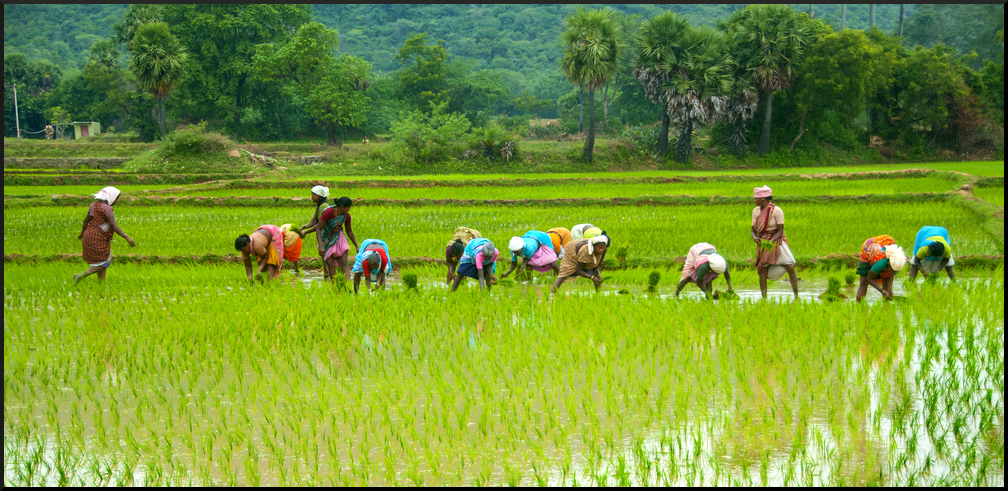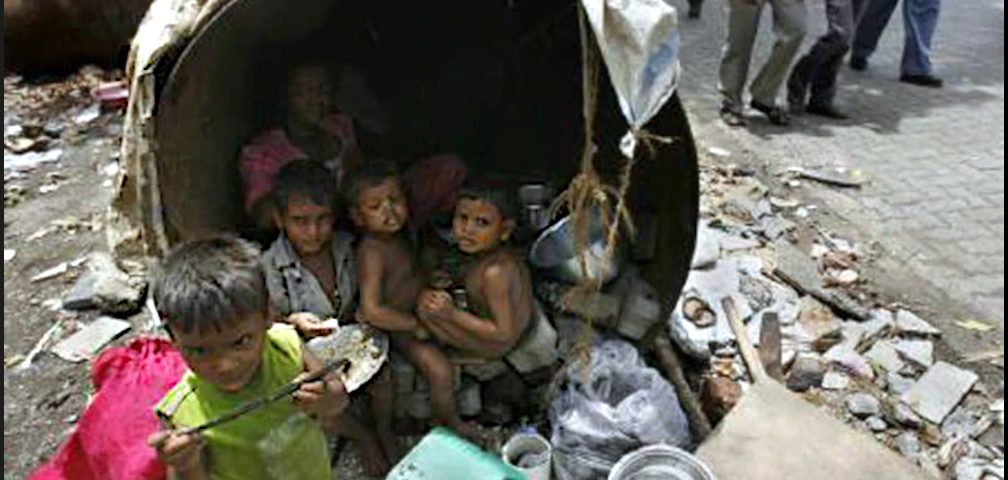by Justin Podur, published on CounterPunch, March 16, 2011
I published the first half of this article here, because it so clearly explains the devastating effect of ‘modernization’ on colonized populations throughout the last couple of centuries. It is important to remember this when we look at the current wars intended to force developing nations to develop in the righteous order of the Imperium. jb
India’s right-wing government has been deploying all the modern tools of repression against a historic farmers’ protest. Much is at stake. For the people of India, their agricultural system is about to get far more precarious. For its farmers, ruin, and bankruptcy for millions, is all but guaranteed. For the government of Narendra Modi and his elite backers, it’s a crossroads moment; they calculate that their political power is assured for decades if they can refashion the politics of rural India and force dependency upon the farmers.
The farmers are protesting because the three farm bills, which were passed by the central government in September 2020, will dismantle the state-run agricultural procurement system in Punjab and Haryana, the breadbasket states of India.
In its defense, the Modi government has simultaneously claimed that the bills will enable a great modernization and also that nothing will change; the billionaires who will benefit (Mukesh Ambani’s Reliance Industries and Gautam Adani’s Adani Group) have denied having any interest in entering the newly privatized business.
The billionaires have been set loose in the henhouse. As Lucas Chancel and Thomas Piketty from the World Inequality Lab at the Paris School of Economics reported, India’s top 1 percent in today’s “Billionaire Raj” have a similar share of the national income as the top 1 percent did under the British Raj.
The “Billionaire Raj” is preparing to turn India back from a country of hunger (on the 2020 Global Hunger Index, India is 94th out of 107 countries) to a country of famine.
Agrarian Crisis Rooted in British Colonialism
The roots of India’s agrarian crisis are far deeper than the three new laws. The seeds of the agrarian crisis were planted in the soil of British colonialism.
Precolonial India was characterized by historian H.H. Khondker in 1986 as a moral economy, a “social arrangement which guarantees a minimum subsistence for all.” In Mike Davis’ book Late Victorian Holocausts: El Niño Famines and the Making of the Third World, he argued that
“Mogul India was generally free of famine until the 1770s. There is considerable evidence, moreover, that in pre-British India before the creation of a railroad-girded national market in grain, village-level food reserves were larger, patrimonial welfare more widespread, and grain prices in surplus areas better insulated against speculation.”
The Mogul state “regarded the protection of the peasant as an essential obligation,” relying on “a quartet of fundamental policies—embargos on food exports, antispeculative price regulation, tax relief and distribution of free food without a forced-labor counterpart—that were an anathema to later British Utilitarians.” The Marathas, another major pre-British power in India, forced local elites to feed the hungry during famines. The British were horrified, calling this the “enforced charity of hundreds of rich men.” The Sikh Empire ruled in Punjab, where many of the protesting farmers are from. Its rulers enacted land reforms even while fighting the Mughals and the British.

Then the British East India Company took over the collection of revenues in Bengal, and the British Empire spread its tentacles across the subcontinent.
Historian Navyug Gill summarized the British system as follows in an article in Outlook Magazine: the British introduced
“caste-based private property, the tethering of revenue demands to cash payments, and embedding agriculture within global circuits of production and consumption… [A]ctual harvests no longer corresponded to taxation rates, and fluctuations in commodity prices meant drastic swings between modest prosperity and widespread impoverishment. A bumper crop could be rendered worthless by uncontrollable forces in far-off parts of the empire, and yet the revenue would still have to be paid. The bane of those who became peasants was being at the mercy of the state as much as the seasons.”
The commodification of food followed—and so did famine.
Providing insights about the extent of famines in India under the British rule, Davis’ book highlights that “[a]lthough the British insisted that they had rescued India from ‘timeless hunger,’ more than one [district] official was jolted when Indian nationalists quoted from an 1878 study published in the prestigious Journal of the Statistical Society that contrasted 31 serious famines in 120 years of British rule against only 17 recorded famines in the entire previous two millennia.” The British imposed new humiliations: “Requiring the poor to work for relief, a practice begun in 1866 in Bengal under the influence of the Victorian Poor Law, was in flat contradiction to the Bengali premise that food should be given ungrudgingly, as a father gives food to his children.”
As H.H. Khondker noted, British writer W.H. Moreland in the 1923 book From Akbar to Aurangzeb “made a distinction between” “work famines” under British imperialism and precolonial “food famines.” During the pre-imperialism period, people starved because of actual food shortages. Under imperialism, people starved because they were poor, had no employment, and therefore couldn’t be fed under a Victorian morality that said you couldn’t get something for nothing.
An Economist article published in 1883, which was quoted in Dan Morgan’s 1979 book Merchants of Grain: The Power and Profits of the Five Giant Companies at the Center of the World’s Food Supply, stated,
“A good wheat harvest is still as much needed as ever to feed our closely packed [British] population. But it is the harvest already turning brown in the scorching sun of Canada and the Western States—the wheat already ripe in India and California, not the growth alone of the Eastern counties and of Lincolnshire, that will be summoned to feed the hungry mouth of London and Lancashire.”
Mass death through starvation was the price of enabling the British Empire to build a truly global, militarized economy in grain, under which agriculture in all reaches of the globe could serve imperial designs and food itself could become a weapon. Food insecurity for the colonies purchased food security for the metropole.
German poet and playwright Bertolt Brecht once wrote, “Famines do not simply occur; they are organized by the grain trade.”
Development experiences between India and China are often compared and can be useful here as well.
Pre-colonized China was even better organized than Mughal India. Before the 1839 Opium War, China under the Qing dynasty “had both the technology and political will to shift grain massively between regions and, thus, relieve hunger on a larger scale than any previous polity in world history,” as Davis explained in Late Victorian Holocausts.
Imperialism in China led to famine there too, the largest of which occurred in 1876. The multiple Opium Wars, which forced the Chinese government to pay massive reparations to its invaders and plunderers, shattered the old food security system. The state “was reduced to desultory cash relief augmented by private donations and humiliating foreign charity,” Davis wrote.
In both India and China, the years of imperialism—the commodification of grain—condemned tens of millions to death by starvation.
Food Security in Independent India and China
Post-Independence, newly sovereign India and China both attempted to get their countries back on the path of food security. Both efforts had initially disastrous results. China had a severe post-Independence famine from 1959 to 1961, worse even than the ones under imperialism. China corrected this trajectory and went on to eliminate hunger and, in 2018, to eradicate poverty as well, as reported at the time by Chinese writer Qin Ling and in Robert Lawrence Kuhn’s documentary film “Voices from the Frontline: China’s War on Poverty,” which was initially aired on PBS before being pulled in May 2020.
In stark contrast with China, India did not have a famine since Independence, but has tolerated chronic hunger. In the most famous comparison of the two countries, economists Jean Drèze and Amartya Sen wrote in their 1991 book Hunger and Public Action that:
“Comparing India’s death rate of 12 per thousand with China’s of 7 per thousand, and applying that difference to the Indian population of 781 million in 1986, we get an estimate of excess normal mortality in India of 3.9 million per year. This implies that every eight years or so more people die in India because of its higher regular death rate than died in China in the gigantic famine of 1958–61. India seems to manage to fill its cupboard with more skeletons every eight years than China put there in its years of shame.”
India’s National Family Health Survey for 2019-20 showed that in Prime Minister Narendra Modi’s home state of Gujarat, sometimes touted as an economic model, 39 percent of children under the age of five have had their growth stunted by malnutrition. The report is full of similar achievements, state-by-state, by the current Indian government. Approximately 25 percent of all hungry people live in India, where around 195 million people are undernourished. Thousands per day, perhaps a million per year, die of malnutrition in India, most of whom are children.
A majority of the population lives in poverty.
This article was produced by Globetrotter, and originally published as “Is Billionaire Raj Trying to Turn India Back to a Country of Famine“.
This article continues in the original publication and on CounterPunch with a rather complex discussion of the current crisis in India brought about by the neoliberal Modi government’s new Farm Laws (which are being fiercely protested by millions of Indian farmers) and their relation to western imperialism. jb
*Featured Image: Indian Farmers Protest block a bridge. Source: Randeep Maddoke; randeepphotoartist@gmail.com
Justin Podur is a Toronto based writer. He is the author of Haiti’s New Dictatorship. He has contributed chapters to Empire’s Ally: Canada and The War in Afghanistan and Real Utopia. You can find him on his website at podur.org and on Twitter @justinpodur. He teaches at York University in the Faculty of Environmental Studies and Urban Change.
